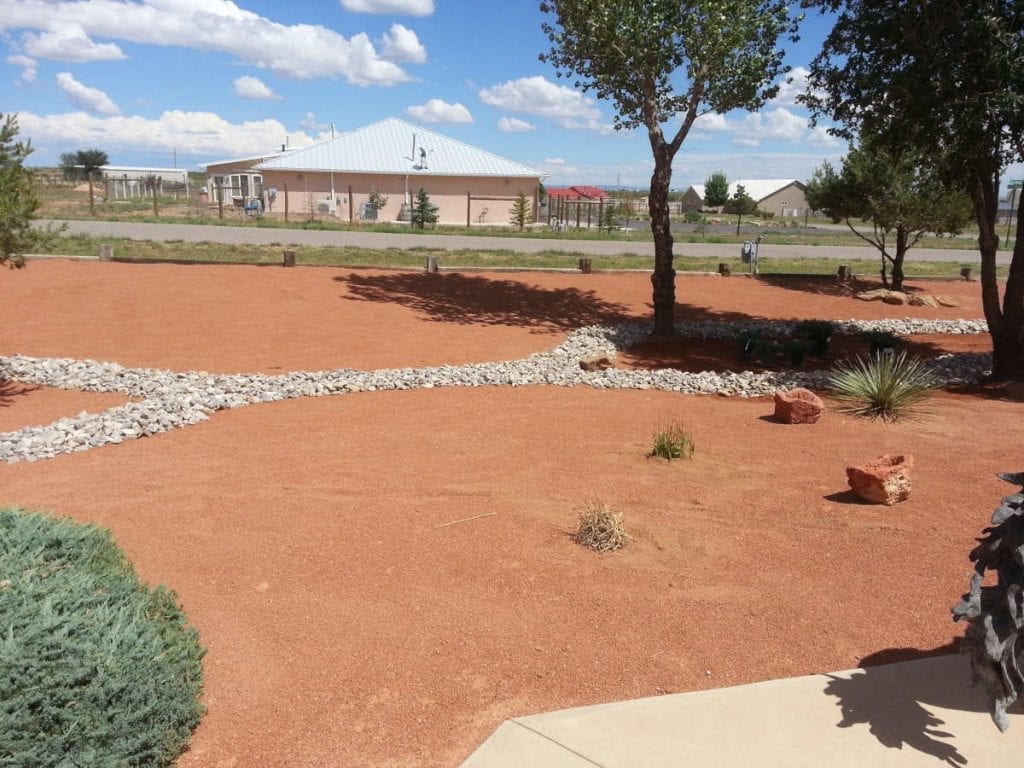What Are the Main Benefits of Xeriscaping My Yard?

You don’t need a lush green carpet of grass to grow your beautiful lawn that your neighbors and the entire neighborhood are envious of!!
Beneficial in more ways than one, xeriscaping is a stunning, water-conservation landscaping alternative that’ll have your yard standing out while protecting the environment.
So, hold off on reseeding your thirsty lawn of turfgrass! Here’s why xeriscaping is earth-friendly and budget-wise.
What Is Xeriscaping
Xeriscaping (it’s pronounced zeh-ri-skayp-ing) is an approach to landscaping that requires little to no irrigation. It is derived from the Greek “xeros,” meaning “dry,” and it is all about creating sustainable spaces in the region you live in, the climate in which it sits.
Xeriscaping doesn’t necessarily call for the elimination of yard turfgrass, but it does call for rethinking whether you really need it and how much you may want to expand or contract its presence on your property.
Xeriscaped lawns include:
- Drought-resistant and drought-tolerant native vegetation (cacti and desert flowers)
- Mulch
- Sand
- Soil
- Rocks
- Hardscaping, such as walkways, pavers, patios, and fire pits
10 Benefits of Xeriscaping
Tired of seeing your water bill peak in summer? Xeriscaping isn’t just for people who live in the desert.
No matter where you are located, you will thank yourself for xeriscaping your yard.
Conserves water
(The point of xeriscaping is to save water: Native plants — plants that have adapted over time to the local climate, soils, vegetation types and rainfall patterns — use much less water to survive than turfgrass, and many can live on the natural rainfall they receive.)
And hydrozoning (grouping plants with similar water needs) cuts down on overwatering and underwatering.
Some parts of the U.S. can expect to lose a third of their freshwater supply within 50 years. Xeriscaping is one way to mitigate water shortages when you need to use less water on lawns so that more can be stored for drinking.
The results? In California, some homeowners have been saving over 120 gallons per day. Homeowners #8230; who xeriscape in Flagstaff, AZ save roughly 8,000 gallons of water annually, about enough to splash more than $275 back in their own pockets.
Saves money
Xeriscaping can lower your water bill by as much as 80%.” And if you choose native plants, you won’t have to spend money on gas for your lawn mower or fertilizer for your grass. Xeriscaping can reduce your annual lawn care costs by a staggering 87%.
A robust xeriscape design constrains grass to one zone, allowing you to water, fertilize and mow as you please only within that zone. The rest of your yard can thrive with little to no extra cost.
Native plants and rocks are a lot cheaper than sod or synthetic grass, so if you can’t seem to manage a typical, ubiquitous green lawn, xeriscaping is a low-maintenance solution that won’t cost a fortune.
Gives you access to financial incentives
Homeowners in many communities receive rebates and reduced bills from local governments for xeriscaping. Southwestern cities and towns—including Las Vegas, NV; Aurora, CO; and Los Angeles, CA—will provide rebates (often relatively small, granted) to entice you to tear up your sod and go low water. If you are a customer of the Albuquerque Bernalillo County Water Utility Authority, you can receive a $3 rebate for every square foot of turf you convert.
Even if you’re not in the desert Southwest, your city or township may offer financial incentives for ripping out your grass lawn and planting a xeriscape yard instead. Consult the website of your local government to determine whether you might qualify for a rebate.
Attracts future buyers
Xeriscaping can add up to 14 percent to the value your property, and is becoming a more popular option as a type of landscaping that doesn’t use as much water. If you want to boost your home’s curb appeal and make a lasting impression on house-hunters with a sense of style, you might want to consider xeriscaping.
Saves time
Xeriscaping requires very little water, mowing, and weeding, which means more time to do what you love over the weekends.
As a rule, drought-tolerant ground covers, perennial flowers, succulents, shrubs and trees need to be watered infrequently (like once every two to three weeks) and some surviving and hardy water-wise native plants don’t need any water once established.
While xeriscapes aren’t entirely hands-free, you can put the mower away and also take a break from weeding: Most ground covers (such as sedum and sage) need just to be cut; and mulch and rocks prevent most weeds from coming in.
Promotes biodiversity
But with habitat for countless native animals and insects disappearing, your xeriscape may be the home and food source they need. Insects likes bees and butterflies love native plants, so you can expect a spectacular show in your own yard soon.
Here are some stunning varieties of wildflowers for attracting butterflies and bees:
- Milkweed (Asclepias, spp.)
- Purple Coneflower (Echinacea purpurea) · Description: Purple Coneflower is a native wildflower with solitary daisy-like flower and brown central cone.
- Black-eyed Susan (Rudbeckia hirta)
- Bee Balm (Monarda spp.)Also known as horsemint, this is another plant that the still rough-and-tough steam pioneer made use of.
- Blanketflower (Gaillardia spp.)
- Coreopsis (Coreopsis).
- Lavandula (Lavandula spp.)
- Goldenrod (Solidago spp.)
- Lupine (Lupinus spp.)
- Aster (Symphyotrichum spp.)
The National Wildlife Federation’s native plant list provides details on the top flowers for your region to attract butterflies fluttering into your yard.
Prolongs the Lifetime of Water Resources Infrastructure
When you save water, you help save everything inside it, including, lo, reservoirs, treatment plants and aquifers. That is, taxpayers (you) need to spend less on resulting damage, repair and rebuilding.
Reduces or eliminates chemical needs
Native plants from xeriscapes are well-suited to your region, and you won’t have to use chemicals and fertilizers that can cause harm. They are specialists in handling your particular soil and weather as well as being resistant to local pests and diseases.
Rock cover also reduces your dependency on chemicals — no need to fertilize your boulders, and you’d get a few odd looks if you sprayed your gravel with herbicide!
Decreases energy use and pollution
The energy to purify water, run a lawnmower, or make fertilizer is also a burden on the environment and wears down your local ecosystem. Xeriscaping helps reduce energy use which means less fossil fuel is burned, more water is available for future use and fewer pollutants make their way into your watershed either on the ground or washed off your yard.
Gorgeous and fun to garden
Xeriscapes help save water and energy, but they also happen to be gorgeous. Gardeners like gardening and like being in a pretty place of flowers, butterflies, and beautiful stones, so many, many people xeriscape their own gardens and yards.
Planting a rock garden, edging a patio or even plotting out a wildflower-filled getaway (with a chair or bench for reading) can be among the most satisfying — and fun — activities, and one that might even inspire your neighbors to follow in your wake.
Principles of xeriscaping
How does a garden qualify as a xeriscape? There are seven basic principles.
- Planning and design
- Soil improvements
- Efficient irrigation
- Limited turf use
- Mulching
- Choosing drought-tolerant and drought-resistant plants
- Maintenance
These ten commandments were culled by the City of Denver in the 1980s in response to water shortages. Today they’re the bedrock of a water-wise, sustainable lawn.
Planning and design
Hydrozoning is even more effective in a xeriscaped yard: Designating zones of similar water and sun needs. Grouping together plants with like water requirements helps minimize waste, as well as overwatering or underwatering.
Soil improvements
Before you plant, test your soil and make the appropriate amendments for your particular xeriscape. Some plants need very fertile, loamy soil, and you might need to incorporate compost and an organic fertilizer.
Efficient irrigation
Rather than oscillating sprinklers that send water up into the sky, xeriscapes use drip irrigation systems or soaker hoses, which reduce evaporation by bringing water directly to the plant’s roots.
Limiting turf use
Granted, xeriscapes don’t need to be free of grass, but they use turfgrass judiciously and only where useful. Maybe you can keep a swath of Kentucky bluegrass in the backyard for the kids and pets to play on, and convert the rest of it to lower-water-use grass, native plants, a rock garden.
Mulching
Mulch for the lawn is a miracle worker. It cools roots in the summer, protects soil from heat in the winter, retains moisture in the soil, helps the soil retain water by reducing evaporation, helps prevent weed growth, and decreases soil erosion. If you’re trying to maintain a healthy, xeriscaped lawn or garden, adequate mulch is a must.
Choosing drought-tolerant and drought-resistant plants
Xeriscaping is really about cutting back the energy and maintenance requirements of your lawn. Xeriscaping and dry gardening use plants that are drought resistant, low-water usage or drought tolerant, and native plants need no expensive fertilizers or harsh pesticides. Our list of the top plants for xeriscaping can aid you in selecting the best plant options for your region.
Maintenance
Xeriscapes need a certain amount of weeding and pruning and trimming and mulching and a bit of watering to remain at their prime. Soil should be aerated annually or every few years (depending on your soil type) and monitored every three to five years.
xeriscaping is a great, eco-friendly landscaping option, there are some drawbacks to consider before you start ripping out your sod.CASCADECOPY Pet-Friendly Landscaping and Its Downsides #3 – xeriscaping While xeriscaping is a fabulous, eco-friendly landscaping choice, there are some drawbacks to consider before you start ripping out your sod.
Xeriscaping …
Decreases the amount of turfgrass you are maintaining, so kids and pets have less space to play. If you have young children, you might decide to wait to xeriscape to make sure they have space for kickball games and pool parties (and if you don’t trust them with the lawnmower, you don’t trust them on the Slip ’N Slide), or you might carve out a smaller portion of your yard for xeriscaping.
Can be costly and take time to install. You will need to remove turf and spread generous layers of compost and mulch, hydrozone, put in a drip irrigation system, plant native plants and add rocks and some sand. Nevertheless, upfront costs and labor can be intimidating, even if you will ultimately save money and time.
Can be difficult to clean up. You’re going to need a leaf pick-up tool (AKA leaf stabber) to collect leaves and debris that have fallen on rocky ground.
Reduces the noise-absorbing and cooling aspects of your lawn. Turfgrass absorbs street noise, and it cools your air seven to 14 degrees Fahrenheit. If there’s less grass, you might hear more traffic, and your air conditioning costs can go up.
May not appeal to property buyers who prefer a traditional green lawn. While xeriscapes usually add value to your property, some home shop-pers prefer the green grass look.
No zeroes for xeriscaping
Xeriscaping is not zero-scaping. That’s a beautiful, low-maintenance landscape design that will make you feel great about your impact on the environment — and about the money remaining in your wallet. If your yard is looking a little lackluster, a xeriscape might be the ideal upgrade to bring your landscape to the 10 out of 10 you want it to be.
To qualify for a rebate, people need to plan their xeriscapes carefully to save every drop of water they can. If you’re busy or just don’t feel like a good sweat in your yard, you can also decide to use your favorite local lawn care pro to change your lawn from thirsty to thrifty in a jiffy.
